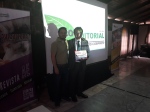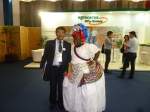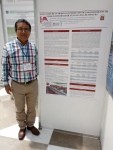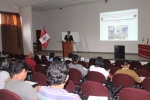INVITACIÓN: Ronda Universitaria: Alltech Young Scientist 2012- 2013- FMVZ-UNICA
ALLTECH Y LA FMVZ-UNICA invitan a la Ronda Universitaria: Alltech Young Scientist 2012-2013, que se llevará a cabo el día martes 11 de Septiembre a las 2:00 pm en la sala de conferencia de la Facultad de Medicina Veterinaria y Zootecnia de la U.N.ICA – CHINCHA
El Premio Alltech Young Scientist une a los más brillantes investigadores de las universidades de todo el mundo. Estudiantes de graduación y de pos graduación envían sus trabajos de investigación en el área agropecuaria, incluyendo medicina veterinaria, zootecnia y agronomía.
La competición del año de 2012-2013 cuenta con 10 regiones participantes. Los ganadores regionales tendrán la oportunidad de participar de la competición global la cual se realizará durante el Simposio Internacional de Salud y Nutrición Animal de Alltech que acontecerá en mayo de 2013 en Lexington, Kentucky, en los Estados Unidos. Los alumnos de pregrado y posgrado competirán separadamente en cada fase.
Información más detallada sobre el reglamento y las diretrices de la competición pueden ser obtenidas en nuestro sitio. Cualquier duda puede ser enviada para el e-mail youngscientist@alltech.com.
Desde el año 2010 la Ronda Universitaria de Alltech se lleva a cabo en nuestra Facultad de Medicina Veterinaria y Zootecnia:
Ese año tuvimos nuestra primera estudiante que participo en ese concurso mundial :
El año 2011 fue la segunda Ronda Universitaria realizada en nuestra FMVZ-UNICA:
Esperamos que este nuevo año 2012, mas estudiantes puedan participar en este concurso mundial, habrá apoyo para los interesados!!
WEBINAR: “DDGS: perspectivas de uso, precios de los granos y etanol”
DDGS: Usage perspectives given grain prices and ethanol industry utilization / DDGS: Perspectivas de uso, precio de los granos y etanol
El uso de los DDGS ha impactado la formulación de alimentos para aves tal y como la conocemos.
Este seminario en línea es parte del 2012 WattAgNet seminario en línea serie y será presentado en español.

DDGS PARA DIETAS DE AVES!!!
Usted aprenderá sobre:
- El mercado de los DDGS en la alimentación avícola y su relación con otras industrias
- Aspectos a tomar en cuenta cuando se formule con este ingrediente
- La variabilidad de la calidad de los DDG
INSCRIPCION EN: https://www1.gotomeeting.com/register/859652641
Speakers

José Artigas
Director de desarrollo de negocios
POET
Estudió en la Universidad de Missouri, en el Departamento de Economía Agrícola. Tiene 30 años de experiencia en el sector agrícola, en el que ha trabajado como director de desarrollo de negocios para Latinoamérica de POET Nutrition, en Monsanto como representante de herbicidas, en Bache como gerente de futuros en la pista de Kansas City y gerente de coberturas financieras, en AGP, Andre-Garnac y FCC como comerciante de granos y coberturas, en Venus International como gerente de granos en Alejandría, Egipto, en EDF Mann como comerciante de futuros y gerente de granos y para POET, como gerente de desarrollo de negocios. Actualmente vive en Kansas City, Missouri, EUA

Mario Zumbado Alpízar
Profesor catedratico de la UCR
Centro de Investigación en Nutrición Animal
Se graduó como Ingeniero Agrónomo – Zootecnista de la Universidad de Costa Rica y tiene un Máster en Poultry Science de la Universidad de Georgia, en EUA. Ha trabajado como profesor catedrático de la UCR en el Centro de Investigación en Nutrición Animal y también en docencia y extensión. Ha sido consultor en nutrición animal de varias empresas como Pipasa – Cargill en Costa Rica y Nicaragua, Granja Avícola Roblealto, Alimentos Montes de Oro y Vymisa de Costa Rica, así como de Molinos de Nicaragua (Monisa) de Nicaragua, DSM de Centroamérica y del Consejo de Granos de EUA. Entre sus principales actividades se encuentran la investigación de ingredientes y programas de alimentación avícola y la asesoría en manejo y nutrición avícola, en reproductoras livianas y pesadas, pollos de engorde y gallinas ponedoras. Cuenta con más de 60 publicaciones científicas o técnicas en nutrición y alimentación avícola.

Dr. Carlos López Coello
Profesor de la Facultad de Veterinaria de la UNAM
asesor del Consejo de Granos de EUA
El Dr. Carlos López Coello recibió la mayoría de su formación profesional en la UNAM: Médico Veterinario Zootecnista, Especialista en Producción Animal: Aves y Doctor en Ciencias Veterinarias. Además obtuvo su Maestría en Ciencias Avícolas de la Universidad de California, Davis, Estados Unidos. Ha sido profesor en la facultad de Veterinaria de la UNAM por 35 años. Imparte cursos de licenciatura y posgrado, en zootecnia, producción, nutrición y sanidad aviar. Además, ha sido productor de pollo de engorda y ha sido socio de INDEPESA (empresa dedicada a la investigación en avicultura) de 1990 a la fecha. Ha sido consultor de aproximadamente 55 empresas avícolas en 15 países de Latinoamérica, entre ellas Bachoco. Es miembro de la mesa directiva y anterior presidente de la Asociación Nacional de Especialistas en Ciencias Avícolas (ANECA) durante 18 años, asociado a la World`s Poultry Science Association y miembro de la Academia Veterinaria Mexicana y del Consejo Nacional de Sanidad Animal Agropecuario. Es autor y conferencista de trabajos técnicos y científicos, y ha presentado 366 conferencias en 26 países, más de la tercera parte en Latinoamérica. Es miembro de nuestro Salón de la Fama.
SUBIDA DEL PRECIO DEL MAIZ Y SOYA IMPACTA LOS COSTOS DE LAS DIETAS Y GENERA PREOCUPACIÓN EN LA INDUSTRIA AVICOLA PERUANA
La producción avícola, tanto en la producción de huevos y carne de pollo, en nuestra zona de Chincha y extensivo en todo el país, esta atravesando por momentos difíciles, básicamente por el aumento de los costos de las dietas como consecuencia de la subida de los precios tanto del maíz y la soya.
CRISIS AVÍCOLA
El maíz ha subido en los últimos meses de US$ 305 a US $ 360 la tonelada. Esta subida impacta el costo de producción final. Según declaraciones de Julio Favre, presidente ejecutivo de Avicola Redondos, menciona que el granjero pierde entre 60 y 70 céntimos por kilo de pollo que vende. Si bien la producción de pollos de carne en nuestro país esta en aumento, llegando a colocarse 281’ 299,086 unidades en el primer semestre del 2012, pero hay una preocupación al respecto.

REINGENIERIA EN LAS FORMULACIONES DE DIETAS AVÍCOLAS ANTE LA CRISIS
El consumidor de nuestra provincia y nuestro país basa su consumo de proteína animal fundamentalmente de la carne de pollo y huevo. Actualmente, se tiene un consumo de carne de pollo per cápita de 37 kilos por persona y de 171 unidades de huevo aproximadamente.
Ante este escenario es necesario aplicar estrategias nutricionales y alimentarias claves que permitan reducir este impacto perjudicial, lo que pasa por una reevaluación de las formulaciones de las dietas.
A continuación se presenta una noticia aparecida en el Sitio Avícola del siguiente link:
http://www.elsitioavicola.com/poultrynews/24834/escasez-de-granos-aumentara-precios-avacolas
EUA – El Consejo Internacional de Avicultura (del inglés, IPC) está preocupado por la escasez mundial actual de granos provocada por la situación de sequía prolongada en las regiones productoras de soja y maíz de Estados Unidos junto con lluvias torrenciales en el norte de Europa. Está teniendo un impacto importante en la producción de carne de ave de todo el mundo.
La producción avícola mundial depende de los alimentos producidos a partir de maíz, soja y otros granos, todos ellos insumos importantes. Debido a la sequía estadounidense, las reservas de maíz y soja mundiales son insuficientes. Al mismo tiempo, la especulación financiera ha empeorado la situación, haciendo que los precios de la soja y el maíz alcancen niveles récord así como han elevado el precio de cosechas de alimentos balanceados, alternativos como el trigo. Además, la producción avícola consume el 44 por ciento de la reserva mundial de alimentos para animales.
Dadas estas circunstancias, el IPC opina que:
- Los precios altos de los granos para alimentos balanceados están empujando el alza en el coste de de la producción avícola. Los aumentos en los precios de productos avícolas son inevitables, y las compañías se ven forzadas a traspasarlos a los consumidores para seguir teniendo solvencia económica. Más aumentos en el coste de los granos conducirá, definitivamente, a recortes adicionales en la producción.
- Por consiguiente, los gobiernos deberían tomar las medidas necesarias para prevenir más aumentos en los granos. La carne de ave ha sido, históricamente, la fuente de proteína animal a gran escala más barata del mundo y ha desempeñado un papel fundamental en el acceso a proteínas de los consumidores en las naciones más pobres. La continuada escalada de los precios de los granos amenaza la seguridad alimentaria, sobre todo en los países con ingresos más bajos.
- Además, las autoridades deberían desalentar la especulación financiera que rodea los precios de los granos para alimentos balanceados. Esa especulación, realizada por entidades que no están directamente relacionadas con el sector del procesamiento de alimentos, ha provocado una volatilidad aún más fuerte en el sector de los alimentos balanceados.Los mercados de derivados no deberían estar acostumbrados a especular económicamente con materias primas tan importantes como los alimentos.
- Las políticas gubernamentales que subsidian o animan la producción de combustibles renovables a partir de granos y cereales deberían revisarse para evitar que haya riesgo de que se produzca una escasez de alimentos.
- MAS INFORMACIÓN: http://www.larepublica.pe/25-08-2012/maiz-sube-us-360-por-tm-y-encareceria-el-pollo-en-el-2013
MI PRESENTACION: XXIV WORLD´S POULTRY CONGRESS-Bahia-BRASIL-2012
EVALUATION OF PROFILES DIFFERENTS OF IDEAL PROTEIN AND EFFECTS ON PRODUCTIVE AND ECONOMIC PERFORMANCE IN ISA BROWN LAYING HEN
Elías Salvador1; Víctor R. Gueva
1Dept. of Animal Production, National San Luis Gonzaga University, Ica, Perú
2Dept. of Nutrition, National Agrarian University, La Molina-Lima, Perú.
INTRODUCTION
The egg-laying hens don’t have a protein requirement per se, if not rather of some levels and adapted balance of the different amino acids. The requirements of amino acids cannot be seen as a fixed concentration in the diet, it should be considered the relationship among the good balance of these in the diets, as well as the relationship between the consumption of amino acids and the production of eggs. However, most of works in ideal protein have been carried out in meat chickens. In our country there are not works reported in egg-laying hens and not being reports regarding the convenience of formulating based on Corn-Soy or fish Corn-Soy-meal. Therefore, the objective of this experiment was to evaluate four profiles of ideal protein and two basal diets with and without fish meal on performance, quality of egg and economic return of egg-laying hens ISA Brown.
MATERIALS AND METHODS
This study was carried out in a Poultry Farm in Peru, for 16 weeks, during the months of November to February, with environmental temperature of 25 to 30 centigrade grades. 448 laying hens ISA Brown of 40 weeks of age was used and distributed in layer cages, each bird had approximately 436 cm2 of floor space. Eight diets were elaborated according to 4 profiles of ideal protein of 4 charts of recommendations (Rostagno et al., 2005; DEGUSSA (2006); N.R.C. (1994) and ISA Brown (2006) and according to two basal diets with Corn-Soy meal or Corn-Soy meal- Fishmeal. All the diets were isocalóricas (2.75 Mcal EM/kg). The level of total sulfur amino acids (Met+Cist.) was fixed in 0.71% in all the diets, next from this level the relationship with the other essential amino acids of each one of the 4 profiles ideals mentioned was established. The productive parameters, egg quality and economic return were evaluated. A randomized complete block design, in arrangement combinatory trifactorial 4 x 2 x 4 (4 profiles of ideal protein x 2 basal diets x 4 periods of evaluation) was utilized. An ANOVA was performed by General Lineal Model (GLM) procedures (SAS Institute, 1998). Differences among treatment means were analyzed using the test of Tukey. Significance of difference was based on the probability of type I error set at P≤0.05. The research was conducted under the ethical standards of the University.
RESULTS AND DISCUSSION
Table 1. Performance of laying hens fed with 4 profiles of ideal protein
|
Egg production |
Feed conversion |
Feed intake |
Egg mass |
Profit |
|||
|
Profiles |
(%) |
(g/g) |
(g/layer/d) |
(g/layer/d) |
($/kg egg) |
||
| Rostagno , | et al., 2005 |
89.945 a |
1.942a |
111.367 a |
57.512ab |
0.40 |
|
| DEGUSSA,2006 |
91.472 a |
1.932 a |
113.938 a |
59.082a |
0.41 |
||
| N.R.C., 1994 |
90.896 a |
1.909 a |
110.670 ab |
57.935ab |
0.39 |
||
| ISA BROWN, 2006 |
85.569 b |
1.906 a |
106.631 b |
56.013b |
0.39 |
||
The production of eggs was better (P<0.05) for egg-laying fed with the profiles from Rostagno et al., 2005, DEGUSSA (2006) and N.R.C. (1994) that of ISA Brown (2006). The reduction in egg production may be due to reduced feed intake of the group of the profile of ISA Brown. Treonina:Lys ratio was 73.7%. The ratio in the other treatment was between 65 to 67%. These differences could cause an imbalance of the amino acid and reduced feed intake. Davis and Austic (1994) found that the activity of the threonine dehydrogenase (TDH) in the isolated hepatic mitochondria of chicken it increased significantly low conditions of threonine imbalance in the diet that leads to the threonine catabolism to glycine and acetil CoA and decrease at level of the blood and probably also to an increment in the competition for the transport of the restrictive amino acid to the brain, since the other amino acids that share the same system of transport are high (Peng et al., 1972) being in a decrease of its concentration in the brain associated with an inhibition of the feed intake (Tews et al., 1979). The profiles of ideal protein had no effect (P>0.05) on the feed conversion, this agrees with the study from Pavan et al. (2005) who reported similar responses in feed conversion. The egg weight was not affected significantly (P>0.05) for the profiles of ideal protein neither for the basal diets. Hens consuming the diet with the profile of DEGUSSA (2006) produced a greater egg mass than hens consuming diets with the profile of ISA Brown (2006). Like was explained previously, the Threonine: Lysine ratio was of 65% for the profile of DEGUSSA (2006) nearer value to the Threonine: Lysine ideal ratio in the egg that is of 68% (Jais et at., 1995), while this ratio in the profile of ISA Brown (2006) of smaller egg mass was of 73% that is a much higher value that the ideal ratio of the egg. Also the Met + Cys: Lysine ratio that was around 89 % in the profile of DEGUSSA (2006), near value to the ideal ratio in the profile of the egg that is of 88% (Jais et al., 1995), and the profile of ISA Brown (2006) this ratio was lower of around 86 %, and were probably one of the factors responsible for the reduction in egg mass. Because is possible that hens consuming diets of DEGUSSA (2006) became more efficient in utilizing the dietary amino acids. The group of egg-laying fed with the diet with profile from Rostagno et al., 2005; DEGUSSA (2006) and the N.R.C. (1994) had a higher specific gravity of egg than the profile of ISA Brown (2006). These results are probably as consequence of a smaller feed intake, nutrients and energy for the group the ISA Brown, since according to Waldroup and Hellwing (1995) and Harms et al. (1998) reported that a high relation exists between the egg weight and the quality of the shell, and that it can be associated to the Met + Cys level in the diet. The highest values Haugh units of the eggs was obtained with the profiles of ideal protein from Rostagno et al. (2005), DEGUSSA (2006) and N.R.C. (1994). However, was a significant interaction (P <0.01) of periods for profiles of ideal protein, in the months of more heat from December until February had a tendency of improvement in the profile of Rostagno et al. (2005) that obtained the values of Haugh units highest compared to the group of ISA Brown (2006) of lower value in each one of the three periods of more heat. The levels of intake of amino acids, especially Met + Cys could also influence in this interaction of the periods for profiles, in view that the consumption of these nutrients was reduced significantly according the periods were but hot since according to the reports of Rodríguez et al. (1996) reported improvements in the Haugh units as the levels of Met + Cys increased in the diets. However, it doesn’t agree with the results found by Camps and Edghil (1999) not affect the egg quality evaluated to the 40 weeks of age negatively. The basal diets had no effect (P>0.05) on egg weight (g), egg mass (g/day), specific gravity and Haugh units. The diet of DEGUSSA (2006) and basal diet corn-soy meal reached the maximum economic return, being of $ 0.43 for kg of produced egg compared to the diet of ISA Brown (2006) that reached a economic return of $ 0.41 for kg of produced egg.
CONCLUSION
The profile of Degussa (2006) y Rostagno et al., 2005 reached the better egg production, feed intake and specific gravity, and the response in feed conversion and egg weight were similar in all treatments. The egg mass was better for profile of DEGUSSA (2006) and the birds fed with the profile from Rostagno et al., 2005 reached the biggest values of Haugh as the periods were hot compared the layers fed with diets from of profile of ISA Brown (2006). The production parameters and egg quality were not affected for the basal diets. The maximum economic return was reached for the profile of ideal protein of DEGUSSA (2006).
REFERENCES
DAVIS, A. T. and AUSTIC, R. E. (1994) Dietary threonine imbalances alters threonine dehydrogenase activity in isolated hepatic metochondria of chicks and rats. Journal of Nutrition, 124:1667-1677.
DEGUSSA (2006) Recommendations for total amino acids in laying hen. Nutritional and Technical support. Germany.
HARMS, R.H., RUSSEL, G. B. and HERLOW, H. (1998) The influence of methionine on commercial laying hens. Journal of Applied Poultry Research, v.7, 45-52.
NATIONAL RESEARCH COUNCIL (1994) Nutrient Requirement for Poultry. 9th rev. ed. National Academy Press, Washington, DC.
PAVAN, A. C., MÓRI, C., GARCIA, E. A., SCHERER, M. R. and PIZZOLANTE, C. C. (2005) Níveis de proteína bruta e de aminoácidos sulfurados totais sobre o desempenho, a qualidade dos ovos e a excreção de nitrogênio de poedeiras de ovos marrons. 568 níveis de proteína bruta e de aminoácidos sulfurados totais sobre o desempenho, a qualidade. Revista Brasileira de Zootecnia, vol. 34, n.2, pp. 568-574.
RODRIGUES, P. B., BERTECHINI, A. G. and OLIVEIRA, B. L. (1996) Fatores nutricionais que influenciam a qualidade do ovo no segundo ciclo de produção. I. Níveis de aminoácidos sulfurosos totais. Revista Brasileira de Zootecnia, v.25, n.2, pp. 248-260.
ROSTAGNO, H. S., TEIXEIRA, A. L., DONZELE, J. L., GOMEZ, P. C., OLIVEIRA, R. F., LOPEZ, D. C., FERREIRA, A. S. and BARRETO, S. L. (2005) Tablas Brasileñas para Aves y Cerdos. Composición de Alimentos y Requerimientos Nutricionales. 2da Edición. Universidad Federal de Vicosa. Brasil
More information:
Elías Salvador Tasayco, Ph.D.
Professor of Animal Nutrition – FMVZ-UNICA
Consultant PRONUTRI – Animal Nutrition
R & D – POULTRY NUTRITION
Blog scientific – academic: https://eliasnutri.wordpress.com/
e-mail: pronutri@hotmail.com ; eliasnutri@yahoo.com
Entrada a Sunampe N° 170 – Chincha-Ica-Perú
Tel.: (511) 056-262531 – (511) 056-271097
Cel.: (511) 956218641 – RPC (511) 984376015


















